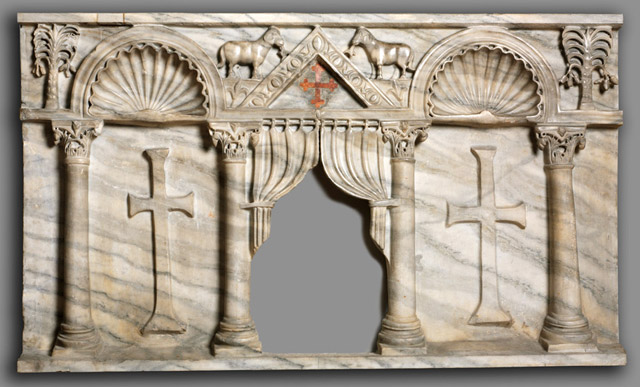Front Panel of a Box-Shaped Altar
The Cleveland Museum of Art, John L. Severance Fund

 Select the image to zoom
Select the image to zoom
This large relief panel is cut from the fine, gray-veined marble typical of the island of Proconnesos in the Marmara Sea near Constantinople. It was long considered to be the front of an early Byzantine sarcophagus, sliced off and reused as an altar frontal in the Church of San Carlino in Ravenna in the later Middle Ages. Indeed, the panel's design with four columns supporting a central gable and two conch-filled arches as well as its decoration with crosses under aediculae, lambs flanking the central gable, and palm trees next to the framing arches, are reminiscent of the decorative vocabulary of fifth- and sixth-century sarcophagi in Ravenna and Constantinople. However, the panel's overall dimensions and its unusual proportions seem to indicate that the relief never formed part of a sarcophagus but that it was instead made to serve as the front panel of a box-shaped altar from the outset. Several altars of this kind or fragments thereof have survived in the churches of Rome (Sant'Alessandro) and Ravenna (San Giovanni Evangelista, Sant'Apollinare Nuovo, and San Francesco), documenting an important stage in the development of the Christian cult of saints and their relics.
Already by the mid-fourth century, a close connection had started to develop between the Eucharistic altar and the tombs of Christian martyrs. In the cemeteries outside of Rome, Constantine the Great built large basilicas to honor the memory of the most important Roman martyrs. As written sources and archaeological evidence indicate, altars were often set up directly above or in front of a martyr's tomb, linking the commemoration of Christ's suffering, death, and resurrection closely with that of the holy martyr. Where martyrs' tombs did not exist, relics were often brought from elsewhere and deposited in a small shrine inside or underneath the altar. The Cleveland relief panel was not only designed to make the altar/tomb connection palpable, but also granted visual and physical access to the saint's shrine and relics by means of a fenestella, or small window. Small pieces of cloth could thus be lowered down to the shrine to literally soak up the miracle-working and salvific properties associated with the saint's bodily remains.




